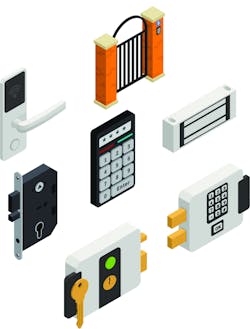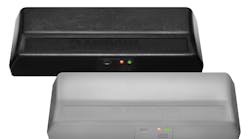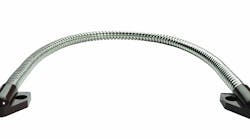All power isn’t created equal, particularly when designing and installing electronic access control (EAC) hardware and systems in new or retrofit applications.
When it comes to power supplies, locksmiths should know that power requirements are different for EAC hardware compared with other devices and that one size doesn’t fit all.
The goal of this series of articles is that after reading it, readers will be able to:
- Successfully approach power considerations for any access control design in a new or retrofit installation.
- Understand how to avoid common installation and operating problems and why EAC hardware has specific power requirements.
- Increase their profit per access control job or installation by avoiding costly callbacks.
- Ensure that the EAC hardware product performance meets and exceeds customer expectations.
Power Problems
Based on almost 50 years of manufacturing electronic access and egress control solutions, including locking hardware and power supplies, SDC has quantified that at least 75–85 percent of access control operating problems and technical support calls are because of power issues, resulting in dead systems, malfunctioning locks or intermittent operation of accessories and controllers, and locking devices that won’t respond reliably.
These issues can be eliminated by following best practices for power design and installation protocols specific to EAC hardware. Access control system power requirements are different from other systems, such as CCTV, because access control systems require steady low-voltage DC current. Access control systems also generally draw higher current during access control-related events, such as when an electric strike is released.
Before selecting a power supply, you should plan ahead to avoid trouble later. This means you should evaluate your project carefully to avoid common installation and operating problems. Consider the following questions:
- What power is required and what power is available (if retrofitting)?
- If retrofitting, what modifications have been made over the years to affect the capacity of the power supply?
- How old is the power supply? If it’s more than 10 years old, replace it.
- Do all products really work together?
- What regional and national codes might be applicable?
- Does your authority having jurisdiction (AHJ) require the installation to be compliant with UL 294, which is an access control standard? Get the AHJ involved in your system design.
- How long must the system function after a power loss?
- Is a low-voltage license required in your jurisdiction?
Also, don’t be afraid to recommend a quality system design. You should plan not to come back, so do it right the first time, and plan for future expansion. Requirements change over time, and no one ever has required less power for their facility’s access control system.
On the Job
Before you select a power supply for your access control system, you must calculate the power load, or current, that’s required for each door opening.
Use a checklist, such as this example, to fill in values and calculate the current load:
Locking device (_____ Amps)
REX button (_____ Amps)
Control panel (_____ Amps)
In/out readers (_____ Amps)
Annunciator (_____ Amps)
Total: (_____ Amps)
Then add a 30 percent safety margin to the total. In competitive bidding situations, you might have to meet the minimum requirements of a job with a 30 percent safety margin. You should combine these for all doors for an overall system total, as well as create subtotals per floor or building.
This will help you to:
- Determine what size power supply is necessary.
- Select and locate the appropriate power supply components.
- Determine wire-gauge requirements based on load, cable distance and voltage drop.
What’s voltage drop? Power supply voltage will drop over long cable distances because of wire resistance. Operating access control devices with inadequate or excess voltage makes them run hotter, wear out faster and operate erratically or not at all. A rule of thumb for access control devices is that voltage drop can’t exceed 5 percent of the supply voltage.
SDC has a Voltage Drop Calculator (https://sdcsecurity.com/Calculators.htm) that allows you to enter the wire gauge, distance and load current in amps to obtain the voltage drop.
Before proceeding, you’ll have to consider what type of power system — centralized or distributed — is best for your installation, because that will affect your voltage-drop calculations. You should add more capacity to allow for future expansion when security requirements change. For more-sophisticated customers who have larger budgets, you should plan for a 50 percent to 100 percent expansion margin, because customers might add doors or devices at existing doors without checking the system’s capacity.
About Power Supplies
With few exceptions, talking about access control power concerns low-voltage, 12- or 24-volt DC power. Unlike security camera or video systems typically deployed throughout a facility, access control locking hardware draws more current, particularly during an event, such as the locking or unlocking of a door. Providing steady, low-voltage DC current requires a power supply to convert incoming AC voltage to DC.
If your project involves multiple doors, there are pros and cons to using one large, or centralized, power supply to meet the system requirements. With a centralized power supply:
PROS
- Supplies are protected from vandalism.
- There’s a single location for the fire-system interface.
- It’s easier to monitor or maintain the power system.
- There’s a lower cost per door because of shorter cable distances and lower labor costs.
CONS
- There’s a single point of systemwide failure, particularly when using one large supply.
- It’s difficult to reconfigure for system expansion.
- Longer, heavier cabling might be required for home runs from the door.
Conversely, distributed power refers to using a power supply for each door. The pros and cons of distributed power are:
PROS
- Adequate power will be provided for each new door.
- It’s easier to accommodate system expansion.
- Shorter, lighter gauge cabling can be used.
CONS
- There’s a higher cost per door.
The point can be made that it also is easier to service everything at the point of failure in a distributed power system, because it’s less complex than a multidoor centralized system.
Types of Power Supplies
Switching power supplies are small, inexpensive and efficient. They use a switching regulator to convert electrical power. The output voltage is regulated through a process called pulse width modulation (PWM). The PWM process generates high-frequency noise. A switching power supply has better efficiency than linear regulators, because the switching transistor dissipates little power when acting as a switch. However, this switching can generate noise, which can be decreased by filtering.
Linear power supplies are considered to be quiet, because there is no high-frequency switching. They only step-down an input voltage to produce a lower output voltage. A linear power supply drops voltage from an AC line to a much lower AC voltage through a large transformer and then uses a series of rectifier circuitry and filtering processes to output clean DC voltage.
As electricity flows through a circuit, it reaches points called loads where energy is drawn away. Loads are objects that use electricity, such as light bulbs. Loads can be divided into resistive, capacitive, inductive or a combination of these types. Resistive loads, such as light bulbs, are the simplest type. Inductive loads, such as the motors or solenoids used in electrified locking devices, tend to experience power surges when they are turned on and off.
With that in mind, what type of power supply is best for access control? Switching power supplies have trouble handling the inductive loads produced by access control locking devices that have coils or solenoids, and the AC noise voltage affects the performance of access control components. Linear power supplies can handle the inductive loads, but they’re inefficient and generate heat. Perhaps the best solution is a hybrid power supply that combines the efficiency of switching supplies with the inductive load-handling capability of linear supplies. These power supplies feature extra filtering to provide clean-noise-free power.
Also, dual-voltage output frequently is required when powering access control panels at 12VDC and door locking devices at 24VDC. Look for 12/24VDC linear power supplies that have various current output capabilities or add-in 12VDC regulator modules to provide output for access controllers, readers or other devices.
As far as what else to look for in a power supply, much of the selection criteria depends on your specific project application. However, other features worth recommending include:
- Field selectable 12 or 24VDC, regulated and filtered.
- Auto resetting output circuit protection.
- Backup battery with isolated battery charger.
- Low-battery disconnect.
- Emergency release input (also the fire alarm input).
- Input, output and battery-status LEDs.
The quality and reliability of electrified hardware brands in today's industry is high. Unless it was installed improperly or damaged during installation, the device probably will operate reliably for years to come. However, if you don’t consider the power and the power supply, you might be headed for trouble down the road. With this knowledge, you can identify potential conflicts between what was designed and what was installed, repaired or upgraded. Remember: Maintaining your reputation and avoiding costly callbacks is important.
Industry associations, such as ALOA (www.aloa.org) and ESA (https://esaweb.org), have a wealth of information, tools and training to assist you in your electrified door hardware and access control projects.
Kerby Lecka is marketing director at SDC – Security Door Controls, which is a U.S. manufacturer of premium-grade access control hardware. Kerby can be reached at [email protected].





